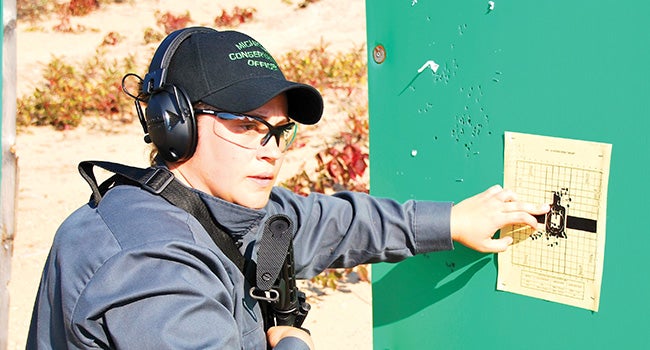Firearms training marks a critical phase in recruits’ development
Published 10:53 am Monday, September 25, 2017

- A DNR officer recruit inspects her bullet placement on a 25-meter target during rifle training last week. Trainees must learn to place their rounds in tight groups to meet accuracy requirements set by the Michigan Commission on Law Enforcement Standards. (Submitted photo)
The recruit steadied her breathing, a chore in itself with fatigue setting in after hours of exposure to the unseasonal September heat.
With her belly on the ground and an eye fixed on the rifle’s front sight, her right index finger pressed backward slowly but deliberately, engaging the trigger until the weapon’s slight recoil and cracking report confirmed that the .223-caliber round was screaming downrange at a sizzling, supersonic speed.
The resulting splash of dirt behind the target backboard became a familiar sight to the men and women of the Michigan Department of Natural Resources Conservation Officer Recruit School, who spent a good portion of week nine practicing with their newly issued Colt rifles and Remington 870 shotguns last week.
The week marked a significant phase in their development as future conservation officers. For starters, recruits were pried from their comfort zones. They left the academy’s familiar confines to spend the week at the Camp Grayling Joint Maneuver Training Center, where they gained proficiency with some of the primary weapons they will have access to as conservation officers. Most important, though, they learned the tremendous responsibilities that come with firearm use.
Recruits were received in true military fashion when they rolled onto Camp Grayling’s sprawling 147,000-acre grounds Sunday night. This was no sightseeing tour. Since Camp Grayling is a National Guard base, instructors thought it only fitting that each recruit be subjected to a military physical training test. The class had to grind through two minutes of pushups, two minutes of situps and a 2-mile run.
Welcome to Camp Grayling, ladies and gentlemen.
After early-morning physical training Monday, recruits were issued their firearms and associated equipment. Firearms are essential tools in law enforcement, and that’s especially true for Michigan conservation officers. In addition to protecting the public, conservation officers may be forced to humanely dispatch animals that are injured or pose safety threats.
But recruits had much to learn before chambering their first round. They spent the morning familiarizing themselves with their Colt LE6920 .223-caliber patrol rifles. By week’s end, each recruit will be able to shoot the weapon, tear it down and reassemble it proficiently.
Monday afternoon’s training went high-tech as recruits took advantage of the Engagement Skills Trainer 2000. The video-based virtual reality trainer is a simulated firing range featuring state-of-the-art graphics and incorporating rifles like the ones used by recruits. Since the system creates a “real time” environment, recruits receive instant feedback from instructors.
“This type of training is a good way for recruits to get the basic fundamentals before heading out to do it for real,” said Conservation Officer Rich Stowe, a DNR firearms instructor.
Recruits welcomed Tuesday as the chance to put their newly acquired skills into action on the firing range. They performed a lot of familiarity drills to enhance proficiency and tactical skills. By day’s end each recruit qualified with the Colt rifle on the 25-meter range.
Also Tuesday, recruits were issued handguns and were fitted with proper grips. The Sig Sauer P229 .40-caliber handgun is carried by all conservation officers and is their primary weapon.
After more “trigger time” on the range Wednesday, recruits were introduced to the other long arm they will carry. The Remington 870 Police Magnum shotgun is the preferred choice of conservation officers when dispatching big game.
Recruits trained with their Remingtons by shooting buckshot and slugs throughout the day, soon learning that this powerful weapon can be used for a variety of tactical responses. “The Remington 870 Police Magnum is designed for close range and is a very effective, powerful weapon,” said Conservation Officer Chuck Towns, a DNR firearms instructor.
Recruits continued working their long guns Thursday, practicing at longer distances and transitioning from strong-side to weak-side shooting. The following morning, recruits were tested on the fundamentals and proficiency they learned during the week. While on the Automated Record Fire range, trainees used their Colts to fire at moving targets that popped up at varying distances and for specific amounts of time. The targets linked to a computer that tabulated each recruit’s scores.
Weapons maintenance was Friday afternoon’s emphasis. Recruits were taught how to disassemble their weapons, clean and lubricate them, and put them back together. With plenty of range time in their futures, recruits will get plenty of practice shooting and cleaning their weapons.
The training at Camp Grayling was right on target, with instructors satisfied that their goals had been met as the week drew to a close.
What’s in store during Week 10? Let’s just say the previously mentioned September heat recruits grappled with on the firing range actually might be welcomed when they encounter their next training challenge.






